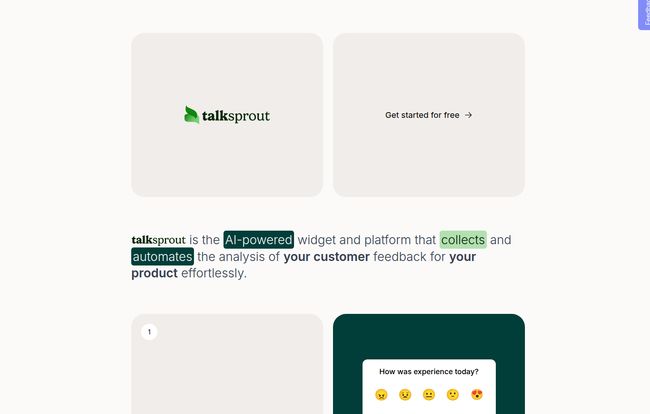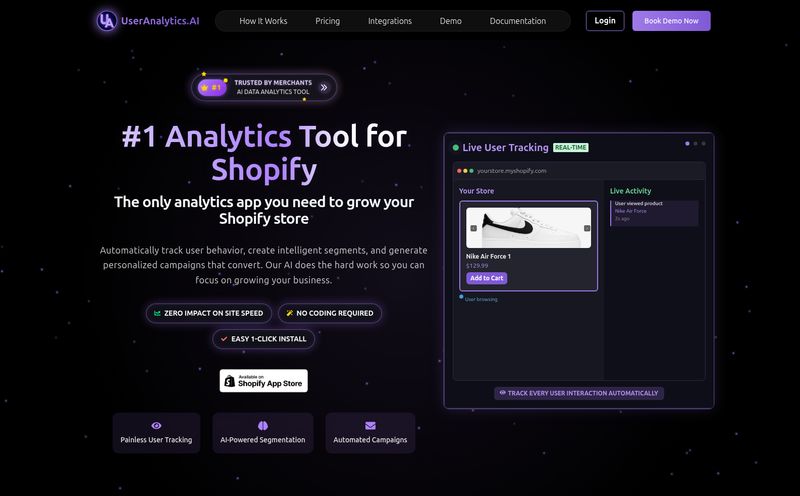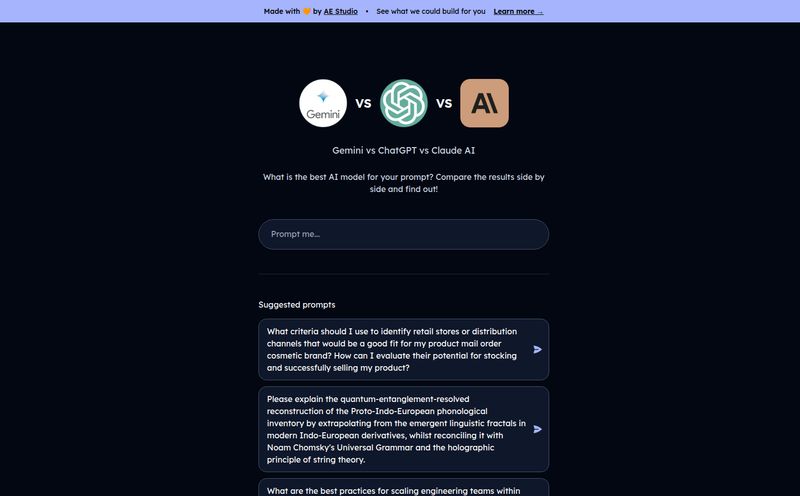If you've ever been on the receiving end of a customer feedback form, you know the drill. You start with the best intentions. You’re excited! Eager to hear what people think. But soon, you're swimming in a sea of spreadsheets, half-formed thoughts, and the occasional all-caps rant about a button being three pixels off-center.
It’s a special kind of soul-crushing work. You're hunting for gold but mostly just panning for mud. For years, the process has been the same: collect, manually tag, try to spot trends, and pray you pull something useful out of the noise. It’s tedious, and frankly, most small teams just don't have the time.
So when a tool like Talksprout lands on my radar, promising to automate the whole shebang with AI, my interest is piqued. My inner SEO and product nerd lights up. Is this another half-baked AI gimmick, or is it something that could genuinely change how we listen to our users? I had to find out.
So, What Exactly is Talksprout?
At its core, Talksprout isn't just another survey widget. We’ve all seen those. No, this is different. Talksprout is an AI-powered platform designed to do the heavy lifting after a user clicks “submit.” It’s a simple three-step dance: Collect, Analyze, and Change.
Imagine you have a junior product analyst on your team. One who never sleeps, never complains, and has been trained on a massive language model. That's the vibe here. It starts with a lightweight, clean-looking widget you pop onto your website. Your users drop their thoughts, and then the magic happens. The platform doesn't just store the feedback; it digests it, understands it, and then presents it back to you with actionable recommendations. It’s a pretty bold claim.
Putting the Features to the Test
A slick landing page is one thing, but does the engine actually run? I decided to kick the tires on its main features.
The Collection Widget: A Breath of Fresh Air
First up, the feedback widget itself. The part your customers will actually see. The claim is that it’s “easy to drop in anywhere on your website in just a few lines of code.” And from what I can see, that holds up. This is a huge plus for teams without a dedicated developer on standby.

Visit talksprout
You can customize the prompts and style to match your brand, so it doesn't scream “tacked-on third-party tool.” It feels native. In a world of intrusive pop-ups and clunky survey modals, Talksprout's approach is refreshingly minimalist. It just sits there, ready when needed. I’ve always felt that the best feedback tools are the ones that don’t get in the way.
The Magic Wand: AI-Powered Analysis
This is the heart of Talksprout. Once feedback starts rolling in, the AI gets to work. It’s not just counting keywords. It performs sentiment analysis, breaking down submissions into Positive, Neutral, and Negative buckets. That’s table stakes for most tools these days, but it’s presented cleanly here.
But the real power move is how it breaks feedback down into the “Why, How, and What.” It doesn't just tell you “10 users were unhappy.” It attempts to synthesize why they were unhappy and suggests how you might fix it. For example, it might turn a dozen vague comments about being confused into a concrete suggestion like:
“Simplify and reorganise the docs page for better clarity.”
That’s not just data; that’s a direction. It also has a built-in chat function powered by GPT. This means you can literally have a conversation with your feedback data. You can ask follow-up questions like, “What are the common themes in the negative feedback this month?” and get a synthesized answer. It’s a fascinating way to interact with qualitative data.
Integrations and the Growing Ecosystem
A tool is only as good as how well it fits into your existing workflow. Talksprout knows this. It already integrates with Slack, so you can get notified of new feedback submissions right where your team lives. Super handy for keeping a real-time pulse on user sentiment.
Now, for a bit of a reality check. Some key features are still on the roadmap. Integrations for Discord and, more importantly, the ability to export your feedback data are listed as “Coming soon.” For a data-driven team that wants to combine this feedback with other sources, the export function is a must-have. It’s a small asterisk on an otherwise impressive feature set.
Let's Talk Pricing: Simple and Straightforward
Ah, the pricing page. The moment of truth for any new tool. I was pleasantly surprised by Talksprout's simplicity. No confusing tiers with arbitrarily withheld features. It’s basically two plans, and they both include all the core functionality.
Here’s a quick breakdown:
| Plan | Price | Best For | Key Limits |
|---|---|---|---|
| Basic | $7 / month | Hobbies and small teams | 300 submissions / month, 1 Seat |
| Pro | $29 / month | Growing companies | Unlimited submissions, Unlimited Seats |
My take? The Basic plan at $7 is perfect for indie hackers or early-stage startups just trying to validate an idea. The 300 submission cap is generous enough to get started. The Pro plan at $29 is where it gets really interesting for established businesses. Unlimited submissions and seats for that price is incredibly competitive. If you have any significant traffic, this is a no-brainer. It's less than a team lunch for what could be a goldmine of product insights.
My Honest Take: Where Talksprout Shines and Stumbles
No tool is perfect. After spending time with Talksprout, here's my unfiltered opinion.
The biggest upside is the sheer amount of time it saves. The automation of feedback analysis is the core promise, and it delivers. It turns a qualitative mess into a prioritized, actionable list. For a small team, this isn't just a convenience; it's a game-changer. The simplicity and ease of setup are also major wins.
On the flip side, the “Coming Soon” labels are a bit of a tease. The lack of data export right now is its biggest weakness, in my opinion. Any serious product manager or marketer will want to get their hands on that raw data for deeper analysis. I'm willing to give them a pass since they're new, but it's something to be aware of. Also, while the AI is impressive, it's not infallible. You still need a human to look over the suggestions and apply context and business knowledge. Don't fire your product team just yet.
Who Should Actually Use Talksprout?
This tool isn't for everyone. If you're a massive enterprise with a complex, bespoke feedback system and a team of data scientists, this might be too simple for you. But you're probably not reading my blog anyway.
Talksprout is tailor-made for:
- SaaS Founders and Product Managers: People who are obsessed with user feedback and want to build a tight product-led growth loop.
- Indie Hackers & Solopreneurs: When you're the entire team, automating a critical but time-consuming task like feedback analysis is priceless.
- Small Marketing Teams: Perfect for gathering testimonials, understanding customer pain points for better copy, and improving user experience on the fly.
It’s for the builders, the movers, and the teams who value speed and efficiency over endless complexity.
The Final Word
So, is Talksprout the future of customer feedback? It’s certainly a compelling glimpse of it. It successfully lowers the barrier to entry for meaningful, ongoing user feedback analysis. It takes the most painful part of the process—the manual sorting and synthesising—and automates it beautifully.
While it has some growing to do (looking at you, data export!), its foundation is solid, its pricing is fair, and its core value proposition is powerful. In an industry flooded with overly complex tools, Talksprout’s focus on simplicity and action is a winning combination. It's a tool I'll be keeping a very close eye on.
Frequently Asked Questions about Talksprout
- What is Talksprout primarily used for?
- Talksprout is used to collect, analyze, and get actionable insights from customer feedback on a website or product. It automates the process of understanding user sentiment and identifying areas for improvement using AI.
- How does the AI analysis actually work?
- It uses large language models (like those behind GPT) to understand the context and sentiment of user feedback. It then classifies the feedback and generates specific, actionable suggestions based on common themes it identifies.
- Is Talksprout difficult to install on a website?
- No, it’s designed to be very simple. It requires adding a small snippet of code to your website, a process that is generally quick and doesn't require deep technical knowledge.
- Does Talksprout support languages other than English?
- Yes, the platform supports feedback collection and analysis in over 40 languages, making it suitable for international products.
- Can I export my data from Talksprout?
- According to their website, the data export feature is “coming soon.” This means it's on their roadmap but not available at the moment of this review.
- Is there a free trial for Talksprout?
- The website has a “Get started for free” call to action, which typically implies either a free trial period or a free-forever plan with certain limitations. It's best to check their site for the most current offer.
Reference and Sources
- Talksprout Official Website
- Talksprout Pricing Information
- The Importance of Customer Feedback (via Hotjar Blog)



